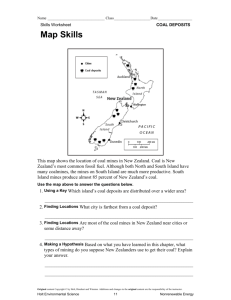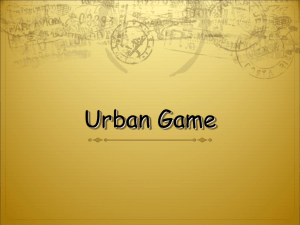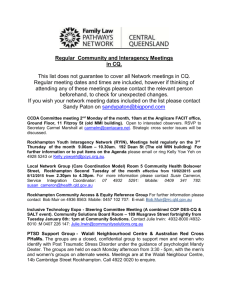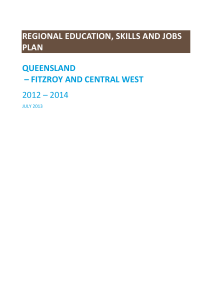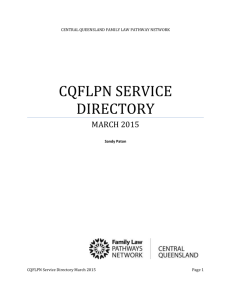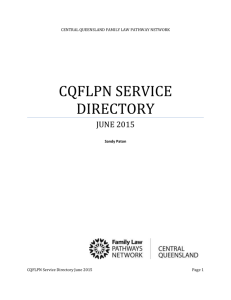Capricorn Conservation Council
advertisement
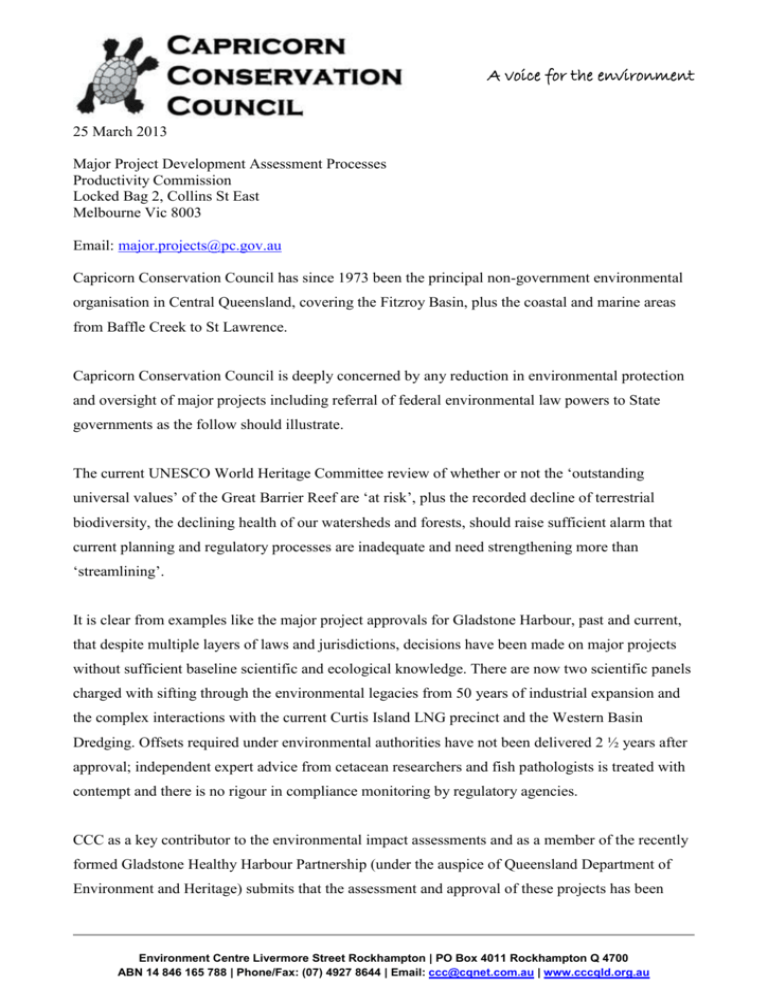
A voice for the environment 25 March 2013 Major Project Development Assessment Processes Productivity Commission Locked Bag 2, Collins St East Melbourne Vic 8003 Email: major.projects@pc.gov.au Capricorn Conservation Council has since 1973 been the principal non-government environmental organisation in Central Queensland, covering the Fitzroy Basin, plus the coastal and marine areas from Baffle Creek to St Lawrence. Capricorn Conservation Council is deeply concerned by any reduction in environmental protection and oversight of major projects including referral of federal environmental law powers to State governments as the follow should illustrate. The current UNESCO World Heritage Committee review of whether or not the ‘outstanding universal values’ of the Great Barrier Reef are ‘at risk’, plus the recorded decline of terrestrial biodiversity, the declining health of our watersheds and forests, should raise sufficient alarm that current planning and regulatory processes are inadequate and need strengthening more than ‘streamlining’. It is clear from examples like the major project approvals for Gladstone Harbour, past and current, that despite multiple layers of laws and jurisdictions, decisions have been made on major projects without sufficient baseline scientific and ecological knowledge. There are now two scientific panels charged with sifting through the environmental legacies from 50 years of industrial expansion and the complex interactions with the current Curtis Island LNG precinct and the Western Basin Dredging. Offsets required under environmental authorities have not been delivered 2 ½ years after approval; independent expert advice from cetacean researchers and fish pathologists is treated with contempt and there is no rigour in compliance monitoring by regulatory agencies. CCC as a key contributor to the environmental impact assessments and as a member of the recently formed Gladstone Healthy Harbour Partnership (under the auspice of Queensland Department of Environment and Heritage) submits that the assessment and approval of these projects has been Environment Centre Livermore Street Rockhampton | PO Box 4011 Rockhampton Q 4700 ABN 14 846 165 788 | Phone/Fax: (07) 4927 8644 | Email: ccc@cqnet.com.au | www.cccqld.org.au inadequate. Consequently we cannot support any diminution of environmental powers, or streamlining of the approval process. Other local examples of potential environmental harm and almost certain economic risks from ‘scaling’ back major project timeframes or proper application of the precautionary principle by minimising or avoiding assessments ecological condition and resilience, would be: The Byfield Coal Port (Waratah Coal) approved by the Queensland Government but rejected under EPBC, similarly Great Keppel Island Pty Ltd proposal would be twice the size and Gladstone Harbour dredging and Curtis Island LNG environmental conditions would be even more inadequate Un-checked state government powers would rubber stamp the Fitzroy Delta and Keppel Bay coal ports with little regard for the fish habitats and the Australian Snub-fin Dolphin. Central Queensland and in particular the Fitzroy River system, the largest catchment entering the Great Barrier Reef lagoon shows clear evidence of the toxic legacy of past and current mining practices with the abandoned Mount Morgan gold, silver and copper mine leaching acidic, heavy metal laden waters into the catchment (Dee, Don and Dawson Rivers). Under the past and existing major project approval frameworks there are 45 large open cut coal mines (plus pending approvals for 35 new mines) in the Fitzroy’s floodplains. These mines currently contain over 250 billion litres of water. Under existing environmental approvals mines are allowed to leave numerous large final voids. Representatives of mining companies have freely admitted (at the Fitzroy Water Quality Advisory Group set following the devastating pollution of the river and GBR from the 2008 flooding of Ensham and other Bowen Basin coal mines) that even with a reduction of their environmental authority requirements for water quality and allowance of much increased discharge rates much ‘that the water might be in the pits forever’. CCC submits that the water management problems of major coal mines projects is another self evident example of why there must be a strengthening not weakening of reduction in project approvals and the regulatory regime. Capricorn Conservation Council has for years raising concerns about coal seam gas and coal mines harming our rivers, wetlands and ground water, including risks to the Great Artesian Basin, so supports the recent announcement of the imposition of federal water powers over major projects. In addition to the coal mine water management issues above, the extraction of CSG in the Surat for the Curtis Island LNG plants is expected to release over 75 billion litres of treated coal seam water Environment Centre Livermore Street Rockhampton | PO Box 4011 Rockhampton Q 4700 ABN 14 846 165 788 | Phone/Fax: (07) 4927 8644 | Email: ccc@cqnet.com.au | www.cccqld.org.au into Dawson River over the next 25 years. The proposed 7,000 CSG wells between Moranbah and Duaringa will have an estimated impact on ground water up to a depth of 800 metres over a 9,000 square kilometre area. Any reduction in assessment and oversight of these CSG projects would create great risk of economic and environmental harm well beyond the horizon of the mooted financial benefits. Another area CCC is concerned about surrounds the four major Fitzroy dam and weir proposals (Nathan Dam, Connors River Dam, Rookwood Weir and Eden Bann Weir expansion) which if approved would destroy the remaining connectivity of this important river system and damage the river’s ecological health, including increasing the threat of extinction of species like the endemic Fitzroy River Turtle Rheodytes leucops. The clear illustration of the failure of conventional economics to consider future negative externalities is the previously mentioned Mount Morgan mine, which produced 262 tonnes of gold, 37 tonnes of silver and 387,000 tonnes of copper between 1882 and 1981, yet despite the massive profits, no-one will invest the estimated $100 million minimum needed to prevent the risk of a catastrophic failure and release of up to 11 million litres of toxic water (pH < 3). While Mount Morgan mine can be dismissed as being from an era of ignorance of environmental matters, the considerable larger current and planned major Central Queensland projects are occurring at a much faster pace, overwhelming the capacity for effective regulatory oversight and adequate peer reviewed scientific scrutiny. CCC endeavours to work constructively with industry and regulatory agencies for example through EIS consultation and membership of groups such as the Central Queensland Mine Rehabilitation Group. Our positive contribution aims to share knowledge which would assist mining companies achieve better nature conservation outcomes, while saving costs from their often wasted efforts to revegetate the poor sodic soils predominant in the Bowen Basin. The message we emphasise above about strengthening not watering down environmental management of major projects is equally expressed by the environmental specialists working for the corporations. Yours sincerely Michael McCabe Coordinator Environment Centre Livermore Street Rockhampton | PO Box 4011 Rockhampton Q 4700 ABN 14 846 165 788 | Phone/Fax: (07) 4927 8644 | Email: ccc@cqnet.com.au | www.cccqld.org.au





